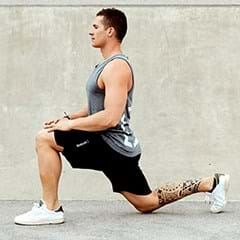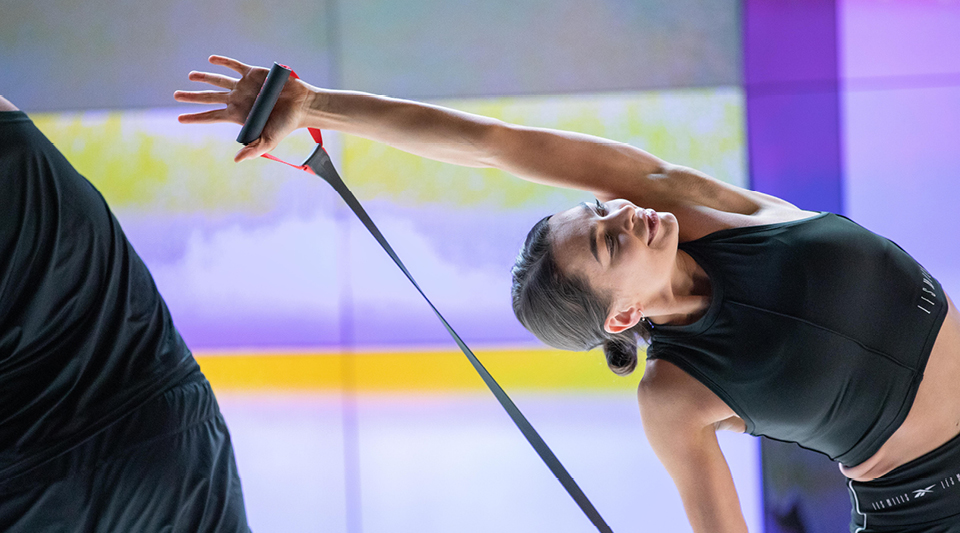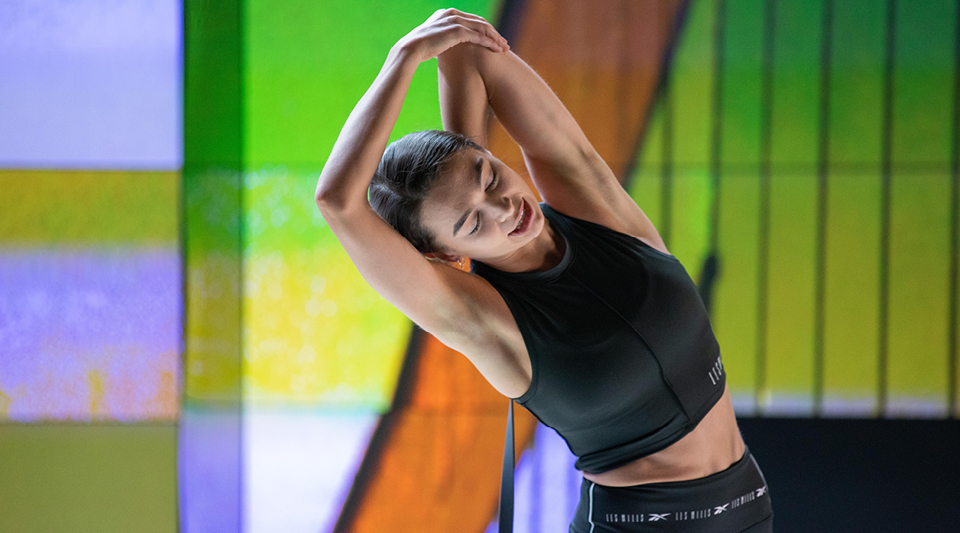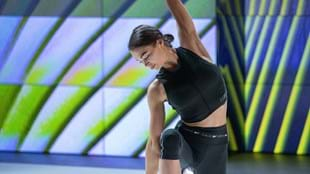Like everything in life, people often seek the silver bullet or “magic” stretch to ease tension or musculoskeletal pain. Unfortunately for us, there usually isn’t one, says Bryce Hastings, Les Mills Head of Research. Having spent 20 years as a rehabilitative physiotherapist, Hastings has seen a wealth of stretching trends come and go – so we sought his expert advice on which tips will stand the test of time.
What are the best types of stretches for your body?
Choosing the best way to stretch comes down to the purpose of the stretch. If your aim is to mobilize before exercise or sport, then dynamic stretches (like backward stepping lunges with a trunk twist or arm swings) are often best. These types of stretches are best-suited to preparing the muscles for the dynamic nature of what lies ahead. If your aim is to address postural imbalances, then long, static stretching is more appropriate.
Which are the best muscles to stretch?
If you're adding a stretch routine into your week, or stretching after class to assist recovery, a general approach is fine. However, if you’re stretching an area due to ongoing pain or tension, it starts to become a little tricky to identify the best target. Working out what muscles to stretch is not always clear cut.
For example, if your shoulders are rounded, it can create discomfort across the upper back. A lot of people try to alleviate this tension by stretching, perhaps clasping the hands in front of the body and pushing the arms forward while rounding the upper back. Intuitively this feels like it’s doing something to address the discomfort, but it’s just stretching tissues that are already lengthened. Often when we assess these people, we find a shortened muscle in the opposing muscle group (in these cases often within the pecs). Stretching these short muscles which are usually not associated with the discomfort is often more effective.
There are many different stretch strategies. What’s your preferred approach?
I like the CRAC approach to stretching, which stands for Contract Relax, Antagonist Contract. This type of stretching is when you use a PNF (Proprioceptive Neuromuscular Facilitation) contract-relax to lengthen the shortened muscle followed by a contraction of the opposing muscle. For example, when applying this to the psoas at the front of the hip, you take the hip flexors into a stretch position, contract the hip flexors against resistance to build tension for three seconds, then relax and contract the glute max (the antagonist to psoas) for 10 seconds. This will take the hip into further hip extension, increasing the stretch on the psoas. The reason this is so beneficial is that the opposing muscle is often dominated by the shortened muscle, so not only are you stretching the short group – you’re also reactivating the less dominant muscle and helping to restore balance.

Bryce Hastings’ all-time favorite stretch
Stretching the psoas (a hip flexor) is often extremely beneficial. We only have 10-15 degrees of extension available at the hip (where the thigh moves behind the body) and we use all of this mobility every time we take a step. Compare this to the hamstrings, which normally allow 90 degrees of hip flexion, of which we only use around 30 degrees when we walk or run. Therefore, losing ten degrees of hamstring length is generally okay. Whereas losing 10 degrees of psoas length is a real problem. Any shortening of this muscle shunts movement that should occur at the hip up into the lower back during each step, and that’s a disaster!
Is it best to stretch pre- or post-workout?
Stretching after a workout is beneficial because the muscles are warm, which can allow you to push a little deeper into the stretch. A post-workout stretch is also a good opportunity to cool down and bring your tissues back to resting level.
A dedicated stretch session is a great way to really focus on postural release and joint awareness. Consider the static position of sitting using a keyboard which many of us do for hours on end. A dedicated mobility session helps to restore balance to the muscles by taking the body out of those sustained postures.
The other benefit of this is increased proprioception (the awareness of your body's position and movements). Our joints and muscles are full of sensors that inform the brain on how we move and the position of our limbs in space. Mobility workouts help to spark up these receptors, which often lie dormant as a result of static postures. The increased sensitivity results in better balance and movement control.
Is becoming more flexible and bendy the main reason to stretch?
I believe the main benefit of stretching is improving movement control and muscle balance. Flexibility is part of this, as is muscle strength and proprioception. For most of us, supreme flexibility is not necessary. In fact, sometimes people who are very flexible or hypermobile have just as many (if not more) injuries than those who lack flexibility.

How can stretching improve your athletic performance?
Resistance training is key to improving athletic performance – and safe and effective resistance training requires movement precision to ensure the load is isolated to the target muscles. If there are imbalances from excessive muscle shortening or training some muscle groups more than others, it can disrupt movement control. A regular muscle balance routine, including stretches targeting the shortened groups, can greatly improve the effectiveness and sustainability of a resistance training program.
Some researchers have found that stretching opposing muscle groups during rest periods when lifting weights can result in more output of the targeted group. For example, stretching the pecs between sets of seated rows increased the number of reps able to be performed in each set.
Intuitively, we might assume that stretching is effective for reducing injury incidence. However, this has proven difficult to demonstrate. One study looked at 1000 army recruits performing basic training. Some were given a conditioning program including stretches, while others acted as a control. After 12 weeks there was no difference in lower limb injury incidence between the two groups. Injury prevention is a complex area, while stretching plays a role in improving muscle function, translating that to less injuries has proven difficult to demonstrate in a research setting. But there is plenty of anecdotal evidence that it helps.

HOW STRETCHING CHANGED THE GAME FOR ONE FITNESS PRO
Two years ago Mark Nu’u-Steele, Les Mills BODYSTEP Program Director, introduced stretching as part of his regular weekly routine, and says he’s been injury free since. “I really feel my new focus on stretching has kept me injury-free, significantly reduced post-workout muscle soreness, and unlocked my stiff and achy joints and lower back.” He adds that he no longer hobbles from bed in the morning with back pain and sore legs.
The stretching has also transformed other aspects of his training too. “I never wanted to try anything new, as I had a mental block about the potential of injuring myself. Now, thanks to my stretching, I feel my body is both mobile and strong enough to try new challenges.”
Mark has recently worked with Kelly Macdonald, a former competitive gymnast and mobility specialist, to develop LES MILLS STRETCH™, a new functional stretching program available on LES MILLS™ On Demand.
“You certainly don’t need to be flexible or experienced to do LES MILLS STRETCH,” says Kelly. “In fact, if you're not that flexible, you'll find LES MILLS STRETCH is ideal. It will help increase your range of motion and you'll see real gains in your flexibility in no time. The more flexible you are, the more potential your body has to become more agile, dynamic, graceful and optimal.”
She recommends the dedicated stretching session as one of the most productive ways to make progress. “Doing one or two stretch classes a week is more productive than spending five minutes flopping around on the floor like a fish out of water after every workout.”
You can also build strength and flexibility with stretches and poses that feature in BODYBALANCE/BODYFLOW.
This article originally appeared in Les Mills Fit Planet.



